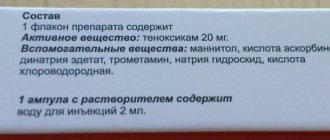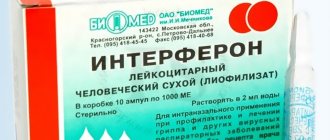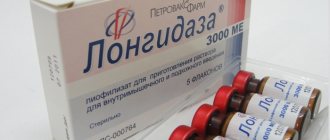| Prescription drug | |
| Release form | Lyophilisate for the preparation of solution for subcutaneous administration 0.25 mg, 3 mg. 0.25 mg or 3 mg each |
| Manufacturer | Baxter Oncology GmbH |
| Active substance | Cetrorelix |
To learn more
Consultations are conducted by professional doctors who have significant experience in solving infertility problems.
Release form, composition and packaging
Lyophilisate for the preparation of a solution for subcutaneous administration in the form of a powder or mass (in the form of a cake) of white or almost white color.
| 1 fl. | |
| cetrorelix (as acetate) | 250 mcg |
Excipients: mannitol.
Solvent: water (1 ml).
Colorless glass bottles (1) complete with solvent (1 syringes), needles (1 needle No. 20 for introducing the solvent into the bottle, 1 needle No. 27 for subcutaneous injection) and alcohol swabs (2 pcs.) - cell packaging contour (1) - cardboard packs. Colorless glass bottles (1) complete with solvent (1 syringes), needles (1 needle No. 20 for introducing the solvent into the bottle, 1 needle No. 27 for subcutaneous injection) and alcohol swabs (2 pcs.) - contour cell packaging (7) - cardboard packs.
Lyophilisate for the preparation of a solution for subcutaneous administration in the form of a powder or mass (in the form of a cake) of white or almost white color.
| 1 fl. | |
| cetrorelix (as acetate) | 3 mg |
Excipients: mannitol.
Solvent: water (3 ml).
Colorless glass bottles (1) complete with solvent (1 syringes), needles (1 needle No. 20 for introducing the solvent into the bottle, 1 needle No. 27 for subcutaneous injection) and alcohol swabs (2 pcs.) - cell packaging contour (1) - cardboard packs.
Analogues substitutes
A substitute for Cetrotide injections can be considered a drug such as Orgalutran, which has the same active substance, pharmacological group and indications for use.
Its price is 7,000 rubles, but it can be prescribed instead of Cetrotide only after a doctor’s permission, as an analogue.
| Drug name | Price | Purchase | Pharmacy |
| ORGALUTRAN SOLUTION FOR SUBcutaneous ADMINISTRATION 0.25 MG/0.5 ML N5 SYRINGES | 6816 rub. | Buy |
pharmachologic effect
GnRH analogue. Cetrorelix binds to pituitary cell membrane receptors and competitively inhibits the binding of endogenous GnRH to these receptors. Cetrorelix dose-dependently inhibits the pituitary secretion of gonadotropins - LH and FSH. In the absence of preliminary stimulation, the onset of inhibition of the secretory function of the pituitary gland occurs virtually immediately after administration of the drug; the duration of action of cetrorelix depends on the administered dose. In women, cetrorelix causes a delay in the rise in LH levels and, consequently, ovulation.
After a single administration of cetrorelix in a dose of 3 mg, the effect of the drug continues for at least 4 days (on the 4th day after administration, secretory function is depressed by 70%). Regular administration of 250 mcg every 24 hours maintains the effect of the drug.
The effect of cetrorelix is completely reversible after cessation of treatment.
Contraindications
Like all medications, Cetrotide has contraindications:
- It cannot be used for liver and kidney failure in a chronic, acute form.
- Prohibited during pregnancy and lactation.
- Not recommended during the postmenopausal stage.
- May have a negative effect if a woman is sensitive to cetrorelix.
It should be used with particular caution in case of possible allergic reactions to the components of the drug and other similar agents.
Pharmacokinetics
Suction and distribution
After subcutaneous injection, cetrorelix is rapidly absorbed, bioavailability is 85%. Pharmacokinetic parameters after a single subcutaneous administration at a dose of 250 mcg and repeated administration (within 14 days), respectively: Cmax - 4.17-5.92 ng/ml and 5.18-7.96 ng/ml; Tmax - 0.5-1.5 hours and 0.5-2 hours; AUC - 23.4-42 ng×h×ml and 36.7-54.2 ng×h×ml.
With subcutaneous administration of cetrorelix in single doses (from 250 mcg to 3 mg), as well as with daily administration for 14 days, linear kinetics of the drug is observed.
Removal
After a single subcutaneous administration at a dose of 250 mcg and repeated administration (over 14 days), T1/2 is 2.4-48.8 hours and 4.1-179.3 hours, respectively. Excreted by the kidneys. Total plasma and renal clearance are 1.2 ml/min × kg and 0.1 ml/min × kg, respectively. The final T1/2 after intravenous and subcutaneous administration averages about 12 hours and 30 hours, respectively.
Cost of the drug
"Cetrotide" can be purchased both at the pharmacy and at the clinic where the patient undergoes IVF. On average, the price is about 10,000 rubles per package, which contains 7 bottles. That is, for each injection you need to pay about 1,400 rubles. Depending on the status of the clinic, location or pharmacy network, the cost may fluctuate. Pay attention to this and remember that price-quality ratio plays a role here, it’s just that many institutions inflate prices for selfish purposes. We also remind you that using the drug for self-medication is strictly prohibited!
CETROTID: DOSAGE
Treatment with Cetrotide can only be carried out by a gynecologist with clinical experience in the use of this drug.
After the first injection, clinical monitoring is required for 30 minutes to identify symptoms of a possible allergic or pseudoallergic reaction to the administration of the drug. At the same time, it is necessary to provide conditions and means for stopping such reactions.
Cetrotide at a dose of 250 mcg (1 bottle) should be administered 1 time/day every 24 hours in the morning or evening.
Administration of the drug in the morning: Treatment with Cetrotide should begin on the 5th or 6th day of ovarian stimulation (approximately 96-120 hours after the start of stimulation) with a gonadotropin preparation, recombinant or isolated from urine, and continue throughout the entire period of gonadotropin stimulation, including the day of administration of the ovulatory dose of human chorionic gonadotropin (CG).
Administration in the evening: Treatment with Cetrotide should begin on day 5 of ovarian stimulation (approximately 96-108 hours after the start of stimulation) with a gonadotropin preparation, recombinant or isolated from urine, and continue throughout the period of gonadotropin stimulation, including the evening preceding the day of administration of the ovulatory dose. HG.
Cetrotide at a dose of 3 mg (1 vial) should be administered on the 7th day of ovarian stimulation (approximately 132-144 hours after the start of stimulation) with a gonadotropin preparation, recombinant or isolated from urine.
After a single administration of Cetrotide in a dose of 3 mg, the effect of the drug continues for at least 4 days. If on the 5th day after administration of Cetrotide at a dose of 3 mg, the size of the follicles does not allow ovulation induction to be prescribed, Cetrotide should be additionally administered at a dose of 250 mcg (1 bottle) 1 time / day, starting 96 hours after administration of Cetrotide at a dose of 3 mg and including the day administration of an ovulatory dose of hCG.
Rules for the preparation of injection solutions and administration of the drug
The first injection must be given by a specialist doctor. After receiving appropriate instructions from the doctor about the symptoms that may indicate an allergic reaction, the consequences of such a reaction and the need for its treatment, the patient can self-administer Cetrotide.
Cetrotide should be injected subcutaneously into the lower part of the anterior abdominal wall, preferably in the area around the navel. To avoid local irritation upon repeated administration of the drug, the injection site should be changed daily.
Cetrotide should only be dissolved using the solvent provided. During dissolution, the bottle must be gently rocked. To avoid the formation of bubbles, do not vigorously shake to speed up dissolution.
Do not use the solution if it is opaque or contains undissolved particles.
From the bottle, draw all its contents into the syringe. This will allow you to administer a dose of cetrorelix of at least 230 mcg when using the drug Cetrotide 250 mcg and at least 2.82 mg when using the drug Cetrotide 3 mg.
The solution should be administered immediately after its preparation.
When self-administering Cetrotide, you must follow the following recommendations:
1. Wash your hands. It is very important that your hands and all equipment necessary for insertion are clean.
2. On a clean surface, place what is needed for the injection (1 bottle, 1 syringe with solvent, 1 yellow-marked needle, 1 gray-marked needle and 2 alcohol-soaked swabs).
3. Open the snap cap on the bottle. Wipe the aluminum ring and rubber plug with one swab and alcohol.
4. Remove the wrapper from the yellow-marked needle. Remove the syringe with solvent from the package. Place the needle on the syringe with solvent and remove the protective cap.
5. Insert the needle into the central part of the rubber stopper of the bottle. Inject the solution from the syringe into the vial, slowly pressing the plunger.
6. Without removing the needle from the bottle, you should carefully rock the bottle until the powder is completely dissolved. Avoid vigorous shaking to prevent bubbles from forming during dissolution.
7. Draw up the entire contents of the bottle into a syringe. If there is any solution left in the bottle, you should turn the bottle over and pull out the needle so that its hole is located immediately under the stopper. If you look from the outside at the inside of the stopper, you can control the movement of the needle and liquid. It is very important to draw the entire contents of the bottle into the syringe.
8. Remove the needle from the syringe and put the syringe down. Remove the wrapper from the gray marked needle. Place this needle on the syringe and remove the protective cap.
9. Turn the syringe over with the needle up and press the plunger until all air bubbles come out of the syringe. Do not touch the needle or allow it to come into contact with any surface.
10. The injection site is in the lower part of the anterior abdominal wall, preferably in the area around the navel. Take a second swab soaked in alcohol and wipe the skin at the intended injection site. You should hold the syringe in one hand, and with the other hand, gently squeeze the skin surrounding the injection site and firmly fix it between your fingers.
11. Take the syringe as you would normally hold a pencil, and insert the needle completely into the skin at an angle of 45°.
12. After the needle is fully inserted, the skin should be released.
13. Carefully pull the syringe plunger back. If blood appears in the syringe, you should act in accordance with paragraph 14. If there is no blood, slowly inject the solution by pressing the plunger. After injecting the entire solution, slowly remove the needle and gently press a swab soaked in alcohol onto the skin at the injection site. The needle should be removed from the skin at the same angle at which it was inserted.
14. If blood appears in the syringe, remove the needle from the skin and lightly press the injection site with a tampon. This solution cannot be used for repeated injection, so the contents of the syringe should be poured out. Then start the procedure over from step 1.
15. The syringe and needles can only be used once. They should be thrown away immediately after use (to avoid injury, protective caps should be placed on the needles).
Reviews
I'm familiar with Cetrotide. It was on my record. A prick, like a prick. I didn't notice anything special externally. Of course, all the necessary processes took place in my body. I bought this drug directly from the clinic. More precisely, it was included in the cost of the entire program. I didn’t look at the exact cost, but I think it’s not cheap. A friend with whom we had time to talk a little said that after Cetrotide her stomach itched. But she took it calmly, because the doctors controlled everything. By the way, she told me that the unpleasant itching lasted only half an hour after the infection. But she and I summed up together that against the background of the entire IVF procedure and the expected result, this is such a trifle.
There are so many special tools in the IVF protocol. I figured everything out myself. I was interested in what they inject and why, and for what purpose. It’s good that the doctor had good patience. He explained everything to me. And this is what I want to say about Cetrotide. When I read the instructions, I was confused by the only point when blood could get into the syringe. It seems impossible to me. I've given injections before. But the manufacturers didn’t write that in vain either. The nurse explained to me that during the injection you simply do not need to pull the piston back, but immediately inject the drug inside. In combination with the medicine there is a very thin needle. It is difficult for her to get into the vessel. By the way, she told me that you shouldn’t give injections from the IVF program yourself. After all, the program is very serious, you cannot allow the slightest little thing to go wrong with the plan.
Drug interactions
In vitro studies have demonstrated a low likelihood of drug interaction when combining the administration of the drug Cetrotide with drugs whose metabolism occurs with the participation of isoenzymes of the cytochrome P450 system, or undergoing conjugation reactions.
Since the possibility of drug interactions cannot be completely excluded during the combined administration of drugs, when collecting an anamnesis, it is necessary to clarify what drugs the patient received shortly before starting therapy, and also warn the patient about the need to inform the doctor about any drugs that she is taking or expects to take during therapy with Cetrotide .
How does the church feel about IVF?
Discussion: 4 comments
- Larisa:
10/07/2018 at 09:59Good afternoon I am in portacol and have been prescribed the drug cetrotide. I mixed up the dates of the injection, it was necessary to put the 6th and 7th, but I did the 5th and 6th, i.e. 7th day without the drug. There is no way to contact a doctor, because... weekend. what are the consequences of my mistake. Thank you.
Answer
Yana (specialist):
08.10.2018 at 19:56
Hello, Larisa! Most likely it’s okay, since the time difference is small, but it’s still better to take the drug on time, because the life of the unborn child depends on it.
Answer
11/14/2018 at 6:17 pm
Can you please tell me if I can put cetrocid on the first day at 8 a.m. and on the second at 10 a.m.?
Answer
- Yana (specialist):
11/19/2018 at 21:38
Hello, Alena! It all depends on the situation; if you are undergoing IVF, be sure to consult a fertility specialist.
Answer
CETROTID: SIDE EFFECTS
From the digestive system: sometimes - nausea.
From the side of the central nervous system: sometimes - headache.
Dermatological reactions: in isolated cases - severe skin itching.
Local reactions: Mild and transient local reactions (for example, redness, itching and swelling) are possible.
Other: rarely (in case of hypersensitivity) - pseudoallergic/anaphylactic reactions.
When the ovaries are stimulated by gonadotropins, the development of ovarian hyperstimulation syndrome is possible, the symptoms of which are a feeling of tension and abdominal pain, vomiting, diarrhea, and difficulty breathing. Treatment is symptomatic.
special instructions
Cetrotide at a dose of 250 mcg is best administered regularly every 24 hours. If you miss the next dose of the drug, you can give the injection at any other time during the same day.
Cetrotide is not recommended for use in women prone to severe allergic reactions, therefore, before using the drug, you should carefully collect an anamnesis to clarify all existing manifestations of allergies.
During or after ovulation stimulation, ovarian hyperstimulation syndrome may occur, in which case symptomatic treatment is carried out.
Maintenance of the luteal phase should be carried out in accordance with generally accepted practice in assisted reproductive technologies.
To date, insufficient experience has been accumulated in repeated stimulation of ovulation using Cetrotide. Therefore, if a repeated course of treatment is necessary, the drug should be prescribed only after assessing the degree of potential risk and the effectiveness of treatment.
Impact on the ability to drive vehicles and operate machinery
Cetrotide does not affect the ability to drive vehicles and other mechanical means.
Application
Instructions for use of Cetrotide include a description of the drug, its composition, release forms, indications, contraindications and possible side effects. It is necessary to familiarize yourself with it before using it.
Cerotide, reviews for IVF, which can be read on forums dedicated to in vitro fertilization, are prescribed only by a specialist. It begins to be administered at the beginning of the menstrual cycle from 5-6 days. The administration continues until the use of hCG, the date of injection of which is determined by an ultrasound examination of the woman.







